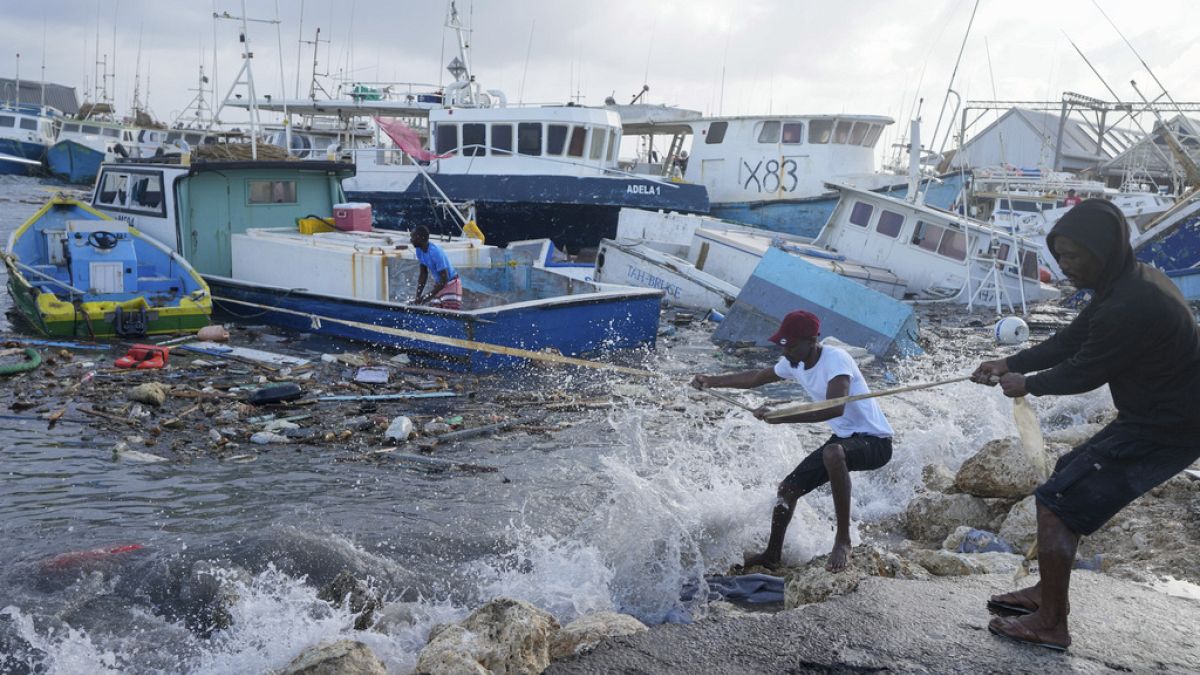The National Oceanic and Atmospheric Administration is warning that this storm season could be the worst in decades.
At least seven people in Jamaica have been killed and thousands of others are left assessing the damage after Hurricane Beryl hit the southern coast of the island in the early hours of Thursday.
While Beryl was downgraded from a “potentially catastrophic” Category 5 hurricane to a Category 4, it remains one of the most powerful ever to hit the country, bringing winds of up to 215 km an hour.
Jamaica’s prime minister Andrew Holness has extended an island-wide curfew to 06.00 local time (11.00 GMT) on Thursday and a flash flood warning is also in effect.
Since leaving the island nation, Beryl has weakened to a Category 3 storm. As of Thursday, it’s rolling towards the Yucatán Peninsula in southern Mexico, according to the US National Hurricane Centre.
What is Hurricane Beryl and what damage has it caused so far?
Hurricane Beryl is the first-ever such storm to reach Category 4 strength in the Atlantic during the month of July.
Despite the downgrade from Category 5, Jamaica’s meteorological service warned that continuing periods of rainfall from the storm could “result in flash flooding over low-lying and flood-prone areas of the island”.
On Thursday morning, more than 400,000 people were without power, according to the Jamaica Public Service Company (JPS).
Taking to X – formerly Twitter – Holness urged residents to “take all necessary steps for your safety and the protection of your property” and thanked “first responders, essential services, security forces and good Samaritans who have assisted others in this time of crisis”.
“This storm will pass, and we will recover,” the prime minister added.
The nearby, smaller islands of Mayreau and Union Island, located in the Lesser Antilles, were even worse hit.
Local reports say about 95 per cent of homes there have been damaged by Hurricane Beryl.
Officials say three people were reported killed in Grenada and Carriacou and another death was recorded in St Vincent and the Grenadines.
In northern Venezuela, three other deaths were reported and four people remain missing, while in Grenada, one person lost their life after a tree fell on a house.
Where is Hurricane Beryl heading next – and what impact might it have?
On Thursday, the hurricane’s path is heading west, reaching the Yucatán Peninsula of Mexico on Thursday night or Friday morning. While it is downgraded to a Category 3, parts of the Peninsula as well as Belize are expecting damaging winds as well as dangerous storm surges and heavy rainfall.
From Friday until early next week, the US National Hurricane Service says the forecast remains uncertain but that Beryl could potentially pose a risk to coastal Mexico and the south of Texas.
If it turns north over the Gulf rather than continuing west, it could possibly hit coastal Texas and Louisiana.
Is it safe to travel to the areas affected by Hurricane Beryl?
The UK foreign office has recommended avoiding Jamaica and the Yucatán Peninsula, but recommends people with plans to travel there “should follow and monitor local and international weather updates from the US National Hurricane Centre and follow the advice of local authorities including any evacuation orders”.
Barbados, Dominica, Antigua and Barbuda, St Lucia, St Vincent and the Grenadines, Grenada, St Kitts and Nevis, and Trinidad and Tobago have all been issued with travel warnings too.
Multiple UK and European airlines have cancelled flights to the region.
A Virgin Atlantic spokesperson told the Independent newspaper, “Due to adverse weather conditions expected from Hurricane Beryl, we are working with the relevant airports and partners to minimise disruption to our services, however some flights are subject to delays and cancellations due to the closure of Barbados airport.
“We are contacting affected customers regarding their travel arrangements.”
St Vincent and Barbados airports remained closed – with the latter not yet offering a date for reopening.
What should I do if my flight to or from the affected region is cancelled?
As always, it’s best to contact your flight and accommodation providers to see what can be done about cancelling or rescheduling your trip.
As some of the region is not under travel warnings, though, the likelihood of getting a refund is slightly less clear than usual.
If your flight is cancelled by the airline or travel agent, however, you have the right to choose between a refund, rerouting or return.
As soon as you choose any of these three options, you’ll no longer have rights to the other two.
The airline is required to get you to your destination as soon as possible – even if it involves travelling with a different carrier.
If they’re not able to offer to reroute you or provide you with a return under comparable transport conditions at the earliest opportunity, they legally have to reimburse your flight cost.
If an airline doesn’t give you the choice to rebook your ticket and you instead buy another ticket to get home under comparable transport conditions, they will give you the price difference between your original ticket and the cost of the new ticket.
You are still entitled to that choice if the cancellation happens after the aircraft took off but was forced to return to the airport of departure.
Airlines are also required to give you a choice between cash or a voucher when reimbursing you.
For more information on cancellations, read our handy guide here.

